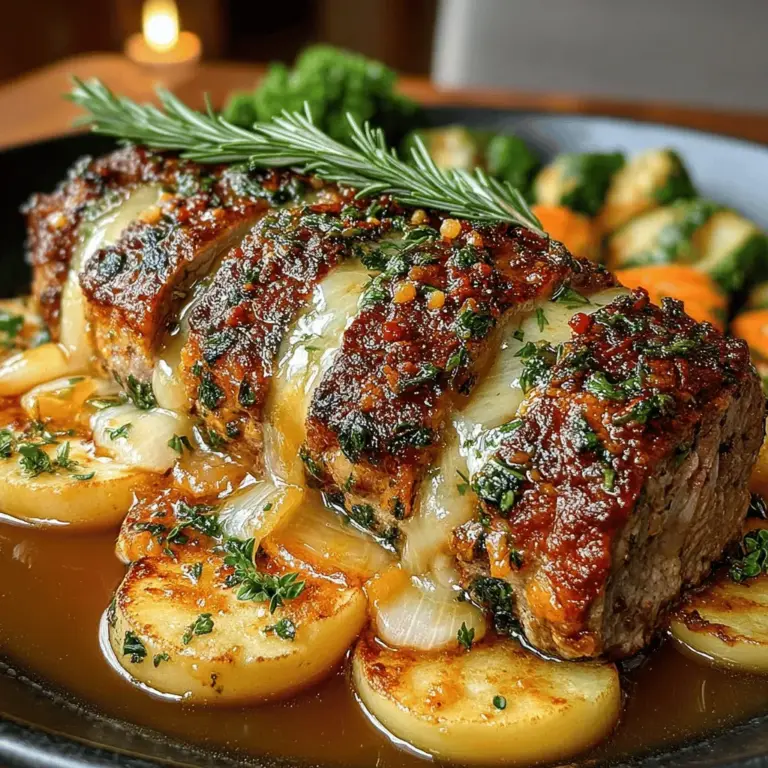Herb-Crusted Pork Loin with Apples: A Comforting Culinary Experience
When it comes to creating a meal that resonates with warmth and comfort, few dishes can rival the succulent allure of herb-crusted pork loin with apples. This recipe encapsulates a delightful balance of savory and sweet flavors, making it an ideal centerpiece for family dinners or special gatherings. The aromatic herb crust envelops the pork loin, providing a fragrant and flavorful experience, while the roasted apples introduce a natural sweetness, perfectly complementing the rich meat.
Imagine the scene: the savory aroma of herbs fills your kitchen as the pork loin roasts, while the apples caramelize in the oven, their sweetness intensifying. This dish not only pleases the palate but also creates an inviting atmosphere, encouraging loved ones to gather around the table. Whether you are celebrating a holiday, hosting a dinner party, or simply enjoying a cozy evening at home, herb-crusted pork loin with apples is a dish that promises satisfaction and delight.
Understanding the Ingredients
To create the perfect herb-crusted pork loin with apples, understanding the key ingredients is essential. Each component plays a significant role, contributing to the dish’s overall flavor profile and texture.
Pork Loin: The star of this recipe, pork loin is prized for its tenderness and mild flavor. It is a lean cut of meat, which makes it ideal for roasting. Choosing a high-quality pork loin, preferably from a reputable butcher, ensures a tender and juicy end result. Look for a cut with a good amount of marbling, as the intramuscular fat will enhance flavor and moisture during cooking.
Fresh Herbs: The herb crust is what elevates this dish from ordinary to extraordinary. Fresh rosemary, thyme, and parsley create a fragrant blend that infuses the pork with vibrant flavors. Fresh herbs not only enhance the taste but also provide health benefits, including antioxidants and anti-inflammatory properties. By using herbs straight from the garden or a local market, you can ensure maximum freshness and flavor.
Apples: The choice of apples is crucial to achieving the right balance of sweetness and acidity. Varieties such as Granny Smith, Honeycrisp, or Fuji are excellent choices, as they hold their shape well during roasting and provide a delightful tartness that cuts through the richness of the pork. The apples not only contribute flavor but also add a beautiful contrast in texture and color, making the dish visually appealing.
Preparing for Success
Preparation is key when it comes to cooking a perfect pork loin. Ensuring the meat is dry and well-seasoned sets the foundation for a flavorful dish.
Drying the Pork Loin: Before seasoning, pat the pork loin dry with paper towels. This step is often overlooked but is crucial for achieving a nice crust when roasting. A dry surface allows the herb crust to adhere better and enhances the browning process.
Selecting the Right Cut: When shopping for pork loin, pay attention to freshness and quality. Look for a cut that is pinkish-red in color with some marbling. Avoid any cuts that appear discolored or have excessive liquid in the packaging. If you’re unsure, don’t hesitate to ask your butcher for recommendations on the best cuts for roasting.
Making Shallow Cuts: To maximize flavor infusion, consider making shallow cuts along the surface of the pork loin. This technique allows the herb paste to penetrate deeper into the meat, enhancing the overall taste. Additionally, it helps the pork cook more evenly.
Creating the Herb Paste
The herb paste is the heart of the flavor in this dish. Here’s a step-by-step guide to crafting a delicious herb paste that will envelop the pork loin in aromatic goodness.
1. Gather Your Ingredients: For the herb paste, you will need fresh rosemary, thyme, parsley, Dijon mustard, olive oil, salt, and pepper. The mustard not only adds flavor but also acts as an adhesive for the herbs.
2. Chop the Herbs: Finely chop the fresh herbs using a sharp knife or a food processor. Aim for a coarse paste that’s not too smooth; you want to retain some texture for optimal flavor distribution.
3. Combine Ingredients: In a bowl, mix the chopped herbs with Dijon mustard, olive oil, salt, and pepper. The olive oil should create a paste-like consistency that can easily be spread over the pork. If the mixture is too thick, add a bit more olive oil until you achieve your desired texture.
4. Taste and Adjust: This is an important step. Taste your herb paste and adjust the seasoning as needed. More salt or pepper can enhance the flavor, but be careful not to overpower the fresh herbs.
5. Apply to Pork Loin: Once your herb paste is ready, generously coat the pork loin, ensuring it is evenly covered. This will create a flavorful crust that caramelizes beautifully during roasting.
Searing the Pork Loin
Searing the pork loin is a crucial step that enhances both flavor and moisture retention. Here’s how to do it properly:
1. Heat Your Skillet: Choose a heavy skillet, preferably cast iron or stainless steel, for even heat distribution. Heat the skillet over medium-high heat and add a thin layer of oil, ensuring it covers the bottom of the pan.
2. Sear the Pork Loin: Once the oil is shimmering, carefully place the herb-coated pork loin in the skillet. Sear each side for about 3-4 minutes, or until a golden-brown crust forms. This caramelization adds depth of flavor and texture.
3. Avoid Overcrowding: If you’re searing multiple pork loins, ensure not to overcrowd the skillet. This can lower the temperature of the pan and prevent proper browning. It’s better to sear in batches if necessary.
4. Check for Doneness: After searing, use a meat thermometer to check the internal temperature. The pork loin should reach an internal temperature of 145°F for optimal juiciness and safety.
Now that you’ve mastered the initial steps, you’re well on your way to creating a mouthwatering herb-crusted pork loin with apples. The next phase involves preparing the apple and onion mixture, which will add an additional layer of flavor and complement the savory pork beautifully.
{{image_2}}
Description of the Flavors and Textures of the Apple and Onion Mix
The combination of apples and onions creates a symphony of flavors that perfectly complements the savory notes of herb-crusted pork loin. As the dish roasts, the apples soften and caramelize, releasing their natural sugars, which meld beautifully with the sweetness of the onions. This mixture not only adds a delightful contrast to the hearty pork but also infuses it with moisture and flavor. The result is a sweet and savory blend that elevates the entire meal, making every bite a harmonious experience.
When choosing apples for roasting, it’s essential to select varieties that hold their shape and flavor during the cooking process. Varieties such as Granny Smith, Honeycrisp, or Fuji are ideal, as they balance sweetness and acidity, which enhances the overall dish. The tartness of Granny Smith apples cuts through the richness of the pork, while Honeycrisp apples provide a juicy sweetness that caramelizes beautifully.
Combining Ingredients for Roasting
To prepare the apple and onion mix, start by thinly slicing your chosen apples and onions. Using a sharp knife, cut the apples into wedges and the onions into half-moons. In a mixing bowl, combine the sliced apples and onions, then drizzle in honey and a splash of apple cider vinegar. The honey adds a touch of sweetness, while the apple cider vinegar introduces a tang that balances the dish beautifully. Toss the mixture well to ensure every slice is coated with the honey and vinegar for maximum flavor.
Instructions on How to Set Up the Baking Dish for Roasting
Once your apple and onion mixture is ready, it’s time to prepare your baking dish. Choose a large, sturdy roasting pan that can accommodate the pork loin and the apple-onion mix. Begin by spreading the apple and onion mixture evenly across the bottom of the pan. This not only serves as a flavorful base for the pork but also helps to keep the meat moist during roasting.
Explanation of the Importance of Chicken Broth in Keeping the Pork Moist
Next, pour a cup of chicken broth over the apple and onion mixture. The chicken broth plays a crucial role in keeping the pork loin juicy and tender as it roasts. It creates a steamy environment that prevents the meat from drying out while allowing the flavors to meld beautifully. Additionally, as the pork cooks, it will release its juices, which will mix with the broth, creating a rich sauce to serve alongside the meat.
Tips for Ensuring Even Cooking and Flavor Absorption During Roasting
To ensure even cooking, position the pork loin on top of the apple and onion mixture. This allows the flavors from the fruits and vegetables to penetrate the meat. For optimal flavor absorption, you can score the top of the pork loin lightly with a sharp knife, creating small slits for the herb mixture to seep into the meat. This method enhances flavor and helps to create a beautiful crust during roasting.
Roasting the Pork Loin
Detailed Roasting Instructions, Including Time and Temperature Guidelines
Preheat your oven to 375°F (190°C). Once your oven is heated, place the roasting pan in the center rack. Roast the pork loin for approximately 25 minutes per pound. For a typical 3-pound pork loin, this will take about 75 minutes. However, cooking times can vary, so it’s essential to monitor the internal temperature to ensure it reaches the desired doneness.
Explanation of the Importance of Basting and How It Enhances Flavor
About halfway through the roasting process, baste the pork loin with the pan juices. This step is crucial, as basting helps to develop a rich, flavorful crust on the meat and keeps it moist. Use a baster or a large spoon to carefully pour the juices over the top of the pork. Repeat this every 20 minutes until the pork reaches an internal temperature of 145°F (63°C), ensuring it remains juicy and flavorful.
How to Check the Internal Temperature for Perfect Doneness
To check the doneness of the pork loin, insert a meat thermometer into the thickest part of the meat, ensuring it does not touch any bones. Once it reads 145°F (63°C), remove the pork from the oven. Remember that the meat will continue to cook slightly while resting, so it’s okay to take it out a few degrees earlier.
Resting and Serving
The Significance of Resting the Pork Loin Post-Roasting
Once the pork loin has reached the perfect temperature, it’s important to let it rest for at least 10-15 minutes before slicing. Resting allows the juices to redistribute throughout the meat, ensuring that each slice is moist and tender. Skipping this step may result in dry pork, as cutting into it too soon will let the juices escape.
Tips on Slicing the Pork for Maximum Tenderness and Presentation
When ready to serve, use a sharp carving knife to slice the pork loin against the grain. This technique helps to break down the muscle fibers, resulting in tender, easy-to-chew pieces. Aim for slices about 1/2 inch thick for a beautiful presentation.
For an elegant touch, arrange the slices on a serving platter atop the apple and onion mixture, allowing the colorful fruit and vegetables to peek through. This not only adds visual appeal but also highlights the delicious accompaniments to the pork.
Presentation Ideas to Elevate the Dish Visually for Serving Guests
To elevate your dish visually, consider garnishing with fresh herbs like thyme or parsley. A sprinkle of freshly chopped herbs not only adds a pop of color but also enhances the dish’s aroma. For an extra touch of elegance, serve with a side of roasted seasonal vegetables or a fresh salad, making the meal a feast for both the eyes and the palate.
Nutritional Information
Breakdown of Calories, Protein, and Other Key Nutrients Per Serving
Each serving of herb-crusted pork loin with apples is not only delicious but also nutritious. On average, a serving (approximately 4 ounces) contains:
– Calories: 320
– Protein: 30g
– Fat: 15g
– Carbohydrates: 18g
– Fiber: 2g
– Sugars: 10g
This dish is a good source of protein, making it a great option for a hearty meal. The inclusion of apples and onions adds fiber and essential vitamins, contributing to a balanced diet.
Benefits of the Dish in Terms of Balanced Nutrition
The herb-crusted pork loin with apples provides a well-rounded meal option, incorporating lean protein, healthy fats, and nutrient-rich fruits and vegetables. The apples not only add sweetness but also provide antioxidants and dietary fiber, which are beneficial for digestive health. This dish can easily fit into various dietary plans, making it a versatile choice for family dinners or special occasions.
Conclusion
In summary, the herb-crusted pork loin with apples is a delightful dish that marries savory and sweet flavors beautifully. The juicy, herb-infused pork pairs exquisitely with the caramelized apples and onions, creating a meal that is both satisfying and sophisticated. The presentation can be easily elevated with fresh herbs and colorful sides, making it perfect for entertaining guests or enjoying a family dinner.
I encourage you to try this recipe and savor the delightful combination of herbs and apples. Whether for a holiday gathering, a special occasion, or a comforting weeknight dinner, this dish is sure to impress. The versatility of the recipe allows for personal adaptations, whether you choose to experiment with different herbs or add seasonal vegetables. Enjoy the process of cooking and the delightful flavors that await!



